Digital Frontier
Header
Main
CG MAKING
The Boy and the Beast
July 2015 [CG]
Integration of 3D conforming to 2D cel by the DF’s ultimate team work
Visual imagery techniques in various mob scenes
For generating the mobs of beasts, the design drawings for beast characters were provided by the studio mapping side for mob settings and the mob characters were added based on those. As the production proceeded, more scenes requiring CG mobs than initially anticipated arose.
Manipulation was done using MotionBuilder. We prepared male and female patterns only and after they were positioned, their character variations were modified using the development team’s tool. There was a character that falls on his bottom in the storyboard, so we created that. In the end, there were 326 bodies in the mob in this cut (sighs of admiration from the staff around the table), which became the scene with the highest number of hand manipulated bodies.
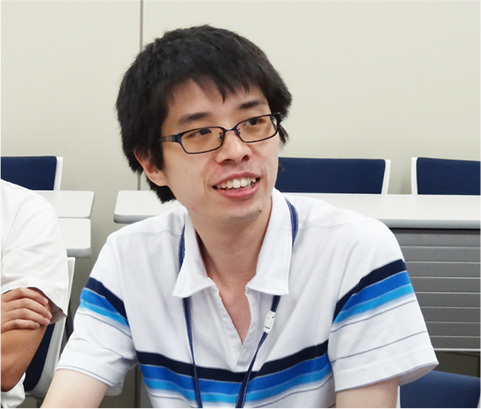 Animator Lead
Animator Lead
Hayato IMATSUJI
I was more or less at my limit myself when the animation team took over this task, so I couldn’t spend much time checking motion captures and I left it mostly up to them to decide how to go about it. I was really surprised when it was finished a week later. But that's a private confession.
The scene of a mob at the stadium
The partnership between the background team and the animation team is critical to the flow for the mob at the stadium.
We anticipated that the spectator stand would have to be modified to match the perspective of the drawing layout. I told the team that one model wouldn’t do (because the layout didn’t match) and asked them to also take care of repositioning the spectators.
In the combat scene in the stadium, the mob moves with the movement of main characters in drawings. If we actually had celluloids, we would be able to continue working by incorporating them so it is easy to see, but inside the stadium, the characters in drawings come in the foreground, so even if we elaborated on movements of the mob, it would blend into the background and get defocused. We ended up putting too much effort into some cuts. When everyone is positioned, a scale of 40,000 bodies was reached, but here, we positioned about 20,000 bodies. Positioning them is relatively easy with Miarmy, but once rendering was done, we had to visually detect where characters themselves or their movements overlapped. Seated mobs were handled using Miarmy and we manually manipulated any distinct movements made by characters walking on the aisles or characters at the forefront.
Approximate positioning was decided by the background team and later on, each cut was loaded to make fine adjustments. Sometimes, the background would change shape because it was in the drawing layout and things that had been positioned could not be used. It would be simple if the area was a clean circle, but when a change of shape happened, rough positioning was done manually first and readjustments were later made.
Depending on a layout (plan), spectator stand was sometimes modeled in 3D as if it was slightly stretched out. In this case, the mob placement had to be changed accordingly and this was done manually. It wasn’t completely manual; we developed a tool that made approximate positioning based on polygons, so that bodies could be placed mechanically to some extent. Overlapping still occurred, so fine adjustments still had to be made manually.
In terms of overlapping parts, we sometimes had a group of bodies that moved in unison, so we painstakingly replayed the cut and changed their movements or moved their position. You can find the singular movement if you look closely. So we reworked it until it looked good. Ultimately, the bodies went into the background and defocused, so I knew I didn’t have to check as thoroughly as I did, but I couldn’t help myself. The more I worked, the more I saw and the more I fixed, but the issue was time [laughs]. There was a vast amount of material, so I had to make sure to moderate myself or set a limit.
Initially, we made the entire mob move in a similar manner, but sometimes, the spectators’ movements seemed too unsubtle, so we went with prominent movements near the front and subtle movements in the distance. Because the drawing is the main focus, I spent a lot of time thinking how much movement should be created by CG and how conspicuous these movements should be. In the beginning, I mulled over whether a movement wasn’t distracting or whether too much movement would be distracting because enhancing the drawings was the goal.
“Lamp mob” with the visual quality of a drawing
While the set up job is thought of as “basically a middle person," it is an important position responsible for handing over optimal data from one team to the next. Parts created by the character team are weighted and finished while being checked to make sure they operate without glitches when combined.
Responding to unexpected requests without fail is also our responsibility. Before this project started, we set aside time to meet with each relevant team to discuss and share our ideal workflows. I believe that this allowed us to avoid putting added pressure on the animation team. For example, an action that is too intense requires many edits in animation. To avoid multiple edits that occur when done by simulation, we animated key frames by hand.
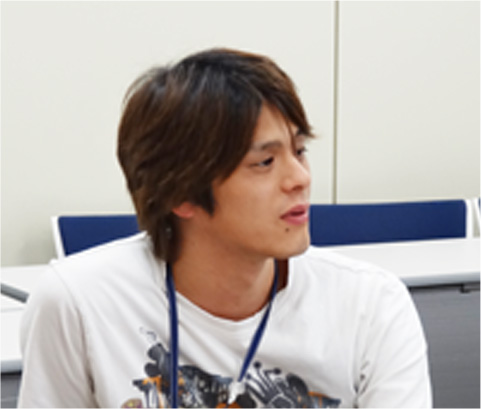 Rigging Lead
Rigging Lead
Ryoji TABUCHI
Traditionally, characters were set up one by one, but this time, it felt like we were involved longer after the setup. After setting up, we made sure that rendering was properly done. The TD team took care of detailed work, but we dealt with issues in design responses and such. For instance, if we were told rendering could not be done, we would find problems with parts. So there was an element of pseudo TD rather than set up [laughs].
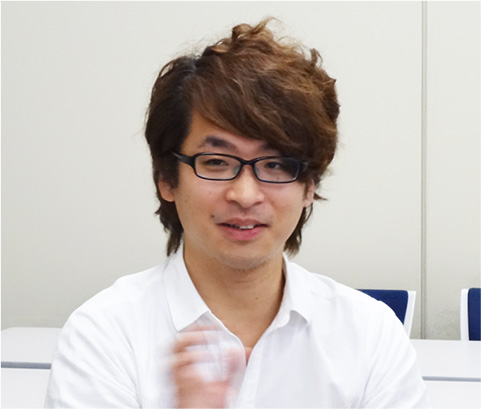 Rigging Lead
Rigging Lead
Hirotaka TANAKA
-
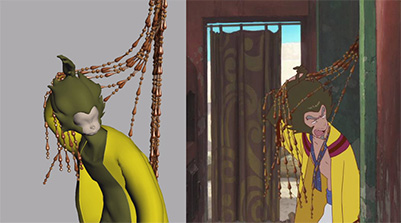

Beaded curtains are a staple in Hosoda’s works. The director decided that they would be done by CG again in this film. To make Tatara (2D) become entangled, Tatara’s collision model was created, to which the movements of a beaded curtain were simulated and then manually touched up.
-
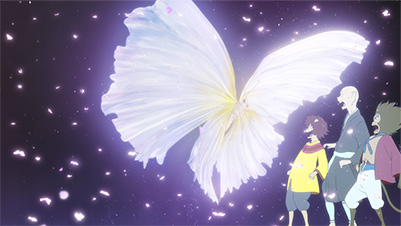

The cut that the director was particular about was created by modeling each frame and put together with animation created by the animation team.
-
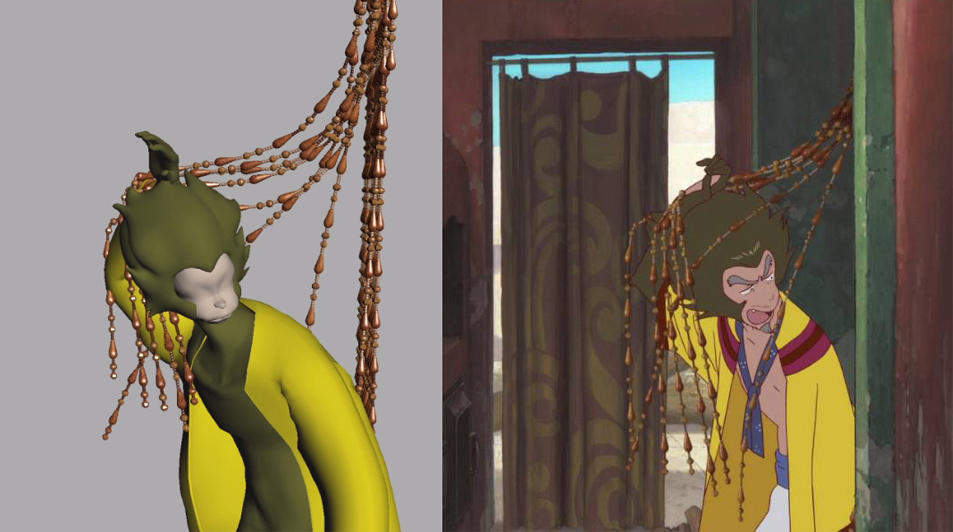
Beaded curtains are a staple in Hosoda’s works. The director decided that they would be done by CG again in this film. To make Tatara (2D) become entangled, Tatara’s collision model was created, to which the movements of a beaded curtain were simulated and then manually touched up.
-
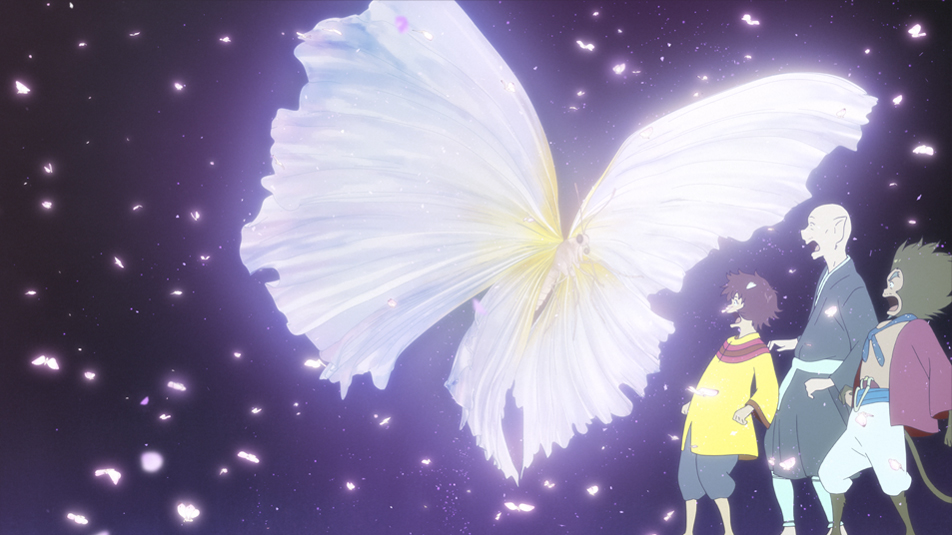
The cut that the director was particular about was created by modeling each frame and put together with animation created by the animation team.
The team’s response to the question – which scene was memorable – was the lamp mobs scene. It is a scene soon after [a character] wonders upon Jutengai in which beasts walk the square carrying lamps and the camera approaches from a low position. It is a scene that brought out the team’s best.
We were told abruptly that the lamp mobs needed to be set up for the next day, so we rushed to prepare it. Then, Kamekawa quickly animated it. When we saw the finished animation, we were awestruck by the brilliant mood it evoked [laughs].
You would mistake the finished work of the lamp mobs as a drawing. While MC based, the characters carrying the lamp were created with higher precision. Time lapsing as the characters approach the camera would make them appear jerky, so we used a full-frame rate (24 fps). The mob in the back was generated using Massive, but the rest were all placed by hand. We worked on imbuing the square with vastness as we placed mobs.
Based on the decision to make certain places move, we created a rig for the lamps here as well to make them swing. There is a lamp string that is wrapped around the waste, which we obsessed over and made it swing with walking. With simulation of the hanging string, the enormous amount of Massive, superb animation and high quality composites, the finished scene, which incorporated everyone’s skills, gave us a sense of accomplishment.
The scene of the car crash under an overpass in Shibuya was also memorable. We had instructions to make a side mirror fall off and a door open so that the passengers can escape, so we set those up. But when the door was opened, there was nothing inside [laughs]. So we worked on the interior, but were told that it was overdone [laughs]. The vehicle is lifted and so we set it up to make a tire fall off.
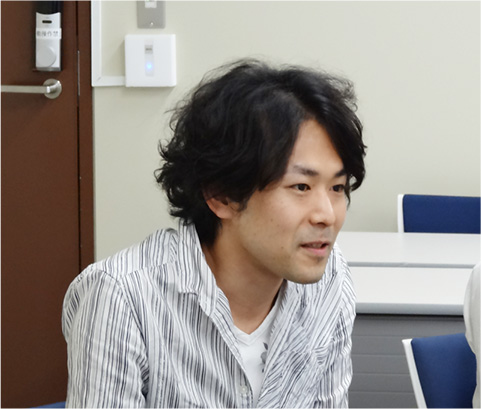 Rigging Lead
Rigging Lead
Ryo KANDA
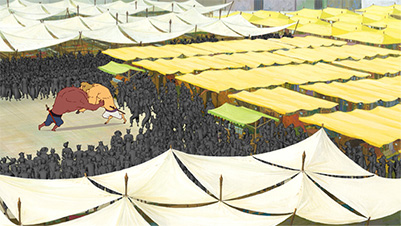
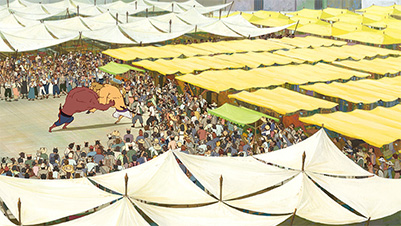
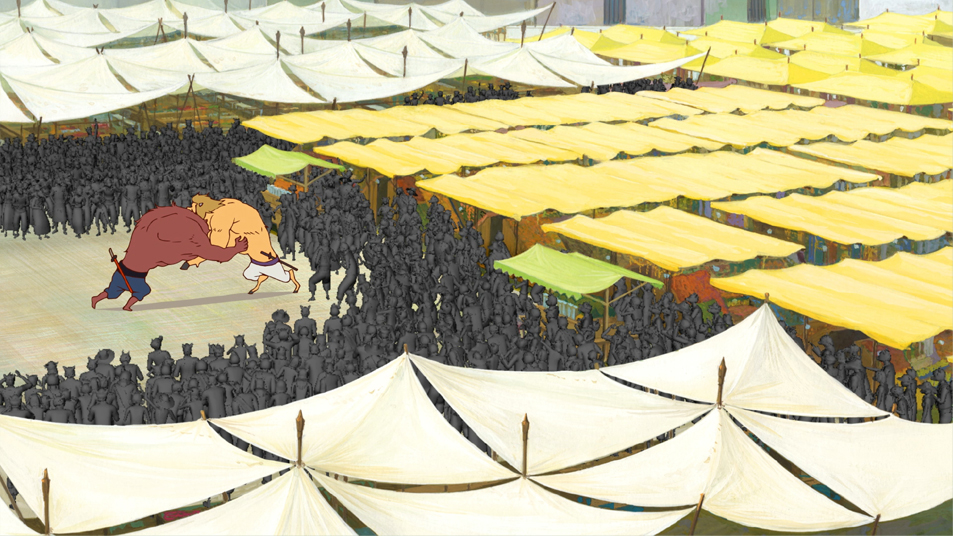
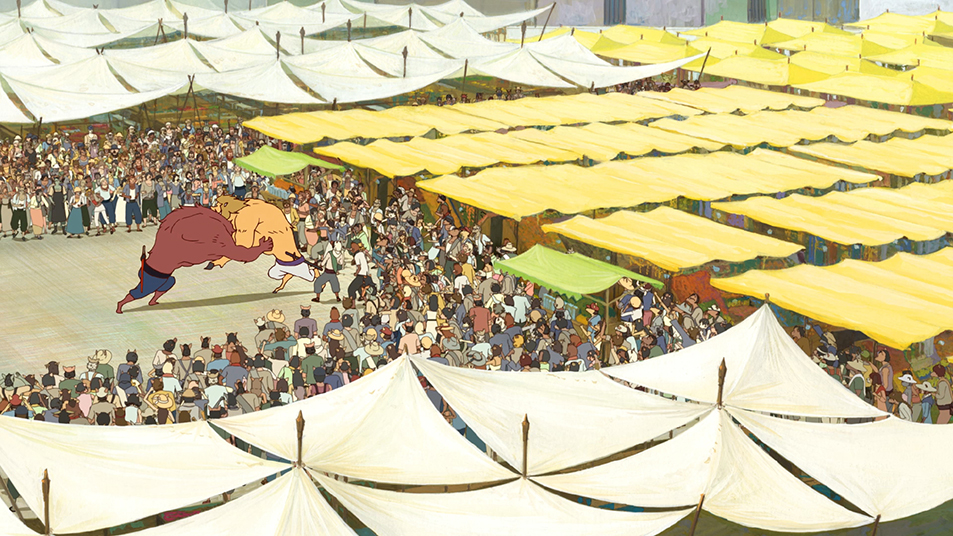
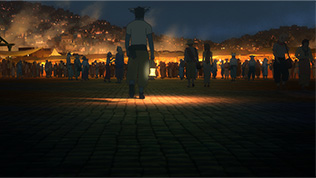
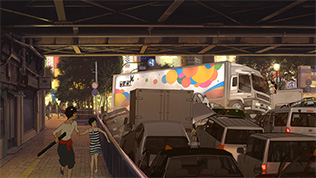
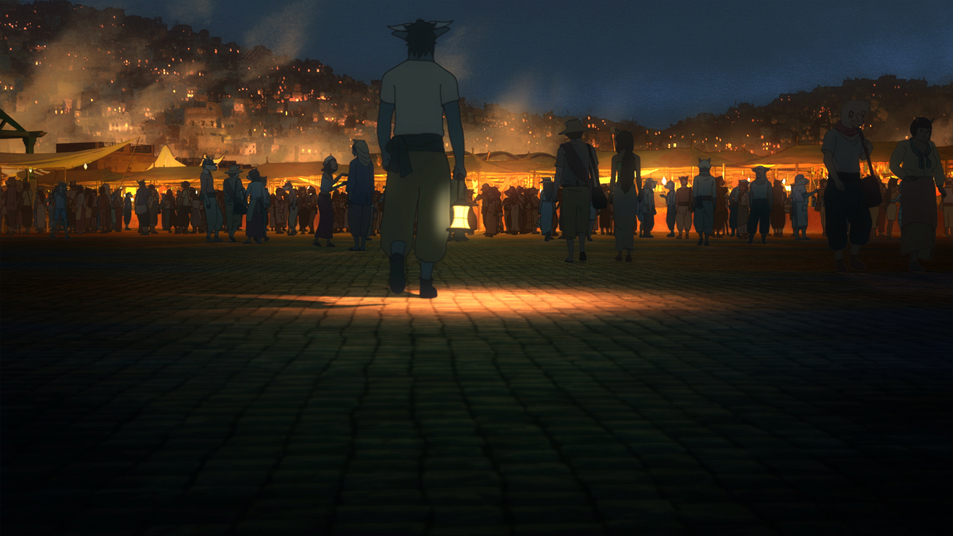
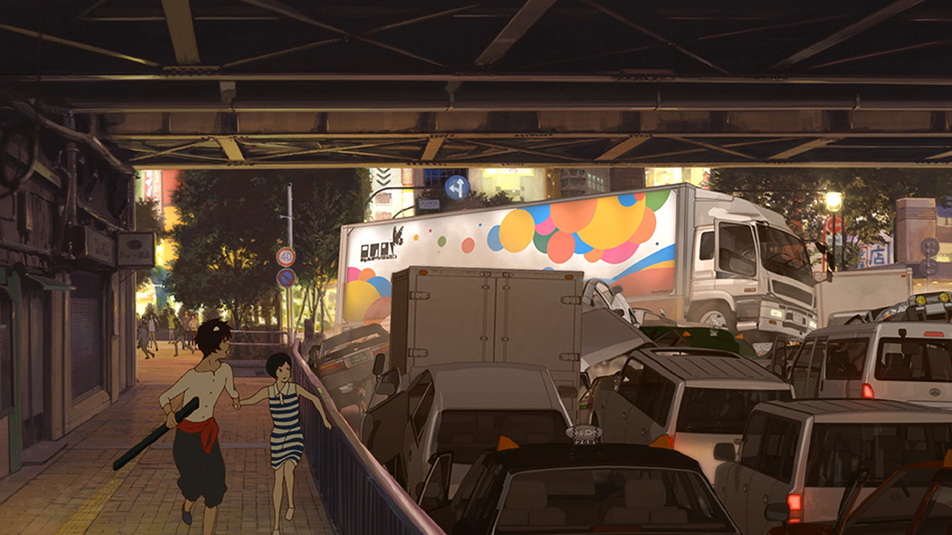
KAME-
KAWA
There is a scene where Kumatetsu and Iozen are sumo wrestling outside and the crowd trickles away. It was supposed to be hand drawn, but in the end, we ended up agreeing that it would be done by CG [laughs]. It was impossible to manually add motion to this many people from scratch, so I grabbed 5 of our staff and asked them to act in the motion capture studio to gather various motion data, which were then deployed. We took a total of 8 blocks worth or so. We created a file with motions numbered A through H.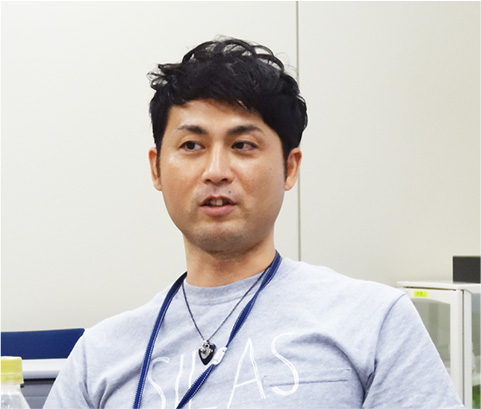 Animator Lead
Animator Lead
Takeshi KAMEKAWA